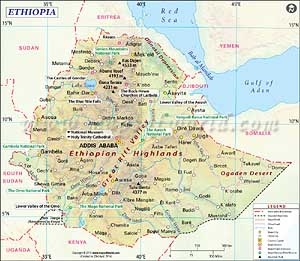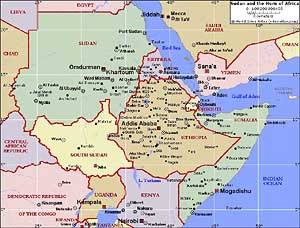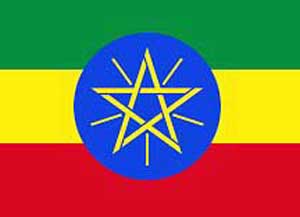-
- Ethiopia Map
|
-
- Map
of the Horn of Africa
|
|
-
|
- latest picture:
November 18, 2015
|
|
-
-
-
-
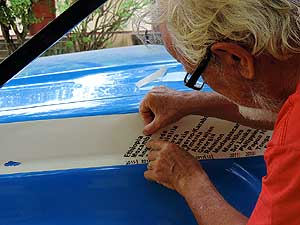
|
-
-
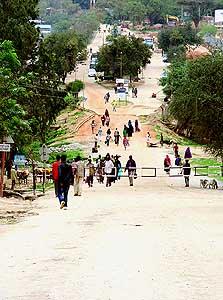
|
-
-
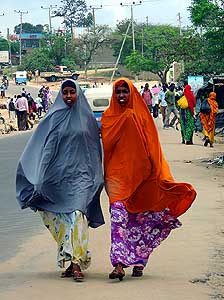
|
- 001
October 25th, 2015: After our
- 516th border crossing from Kenya to
- Ethiopia in Moyale, Emil adds as our
- 183rd country “Ethiopia” to
- our country ribbon
|
- 002
Gate at the border crossing in
- Moyale: While on the Ethiopian side
- the road is tarred, its counterpart on the
- Kenyan side is dusty and broken gravel
|
- 003
Two ladies in a Muslim outfit.
- In Moyale – not like in otherwise
- Christian Ethiopia – the population is
- surprisingly almost entirely Muslim
|
-
|
-
-

|
-
-
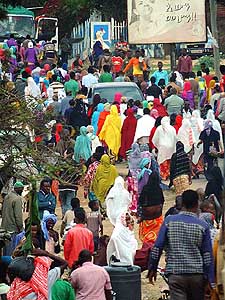
|
-
-
-
-
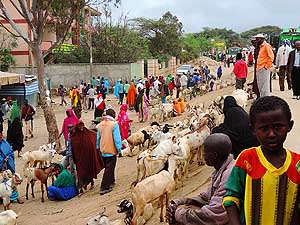
|
- 004
A young lady in Moyale attracts
- attention with her green,
- beaded headscarf
|
- 005
A crowd of colorfully dressed people
- are populating Moyale’s only main street.
- Ethiopia has 90m people with a
- yearly growth of 3%
|
- 006
The Monday market in Moyale is
- in full swing: Goats are being traded;
- news and pleasantries exchanged.
- The atmosphere is lively
|
-
|
-
-
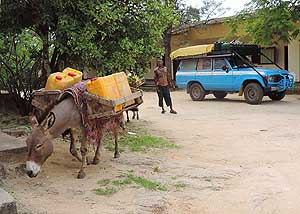
|
-
-
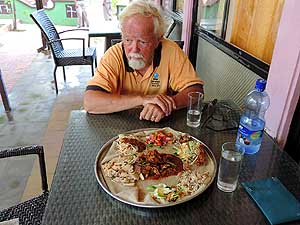
|
-
-
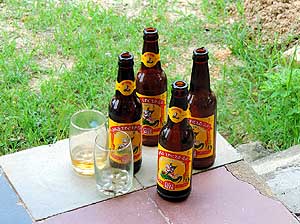
|
- 007
We sleep in the parking lot of
- the “Bekele Mola Hotel” in Moyale.
- The daily water supply is carried by
- donkeys from a nearby water tower
|
- 008
Emil sits skeptically in front of the
- national dish “Injera” – a sourly flatbread,
- arranged with small heaps of stews,
- salads, rice, vegetables and meat .….
|
- 009
….. after the spicy food we
- quench the thirst with four bottles
- of the local St. George Beer at
- our hotel-camping
|
-
|
-
-
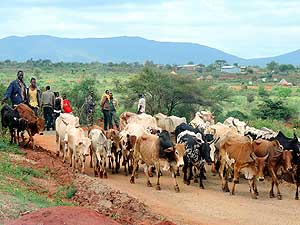
|
-
-
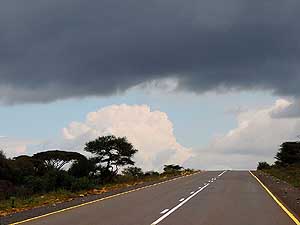
|
-
-
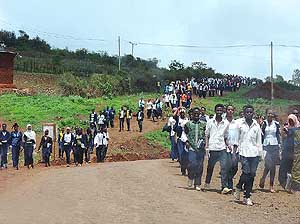
|
- 010
A herd of cattle occupies the whole
- street. The larger the herd, the more
- respected the owner, even if there’s
- nothing anymore around to chow
|
- 011
A dark cloud promises rain –
- a blessing for the country that already
- shortly after the rainy season is
- threatened by a severe drought
|
- 012
The stream of students leaving
- their university never ends. What
- future do these young people have?
- Who gives them work?
|
-
|
-
-
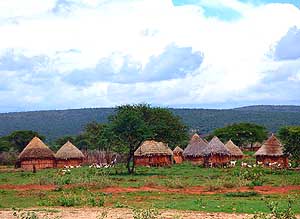
|
-
-
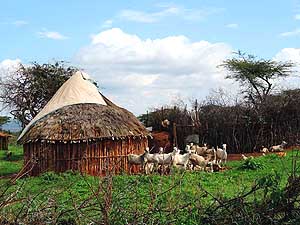
|
-
-
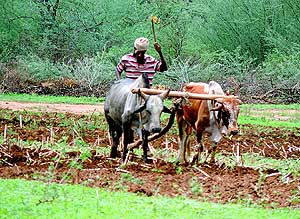
|
- 013
Villages with round thatched huts
- are still widespread in Ethiopia.
- Daily life is still performing as it
- did decades and centuries ago
|
- 014
Goats gather around the simple
- hut. They need little to survive and are
- a milk and meat source for the people
|
- 015
A farmer is working on his
- field the ancient way with his two
- oxen and a one-furrow plow
|
-
|
-
-
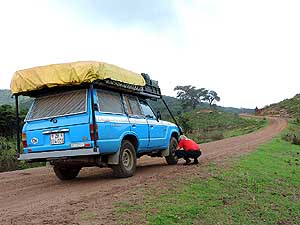
|
-
-
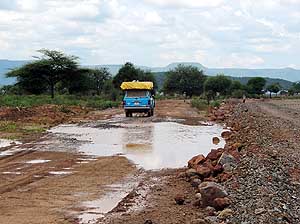
|
-
-
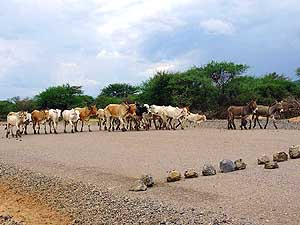
|
- 016
We are ready to hit the 60 miles
- [100km] bumpy gravel road from Yabelo
- to Konso. Emil deflates the tires …..
|
- 017
….. after about one third of the
- distance, Chinese road work is on its
- way. The track itself deteriorates …..
|
- 018
….. a herd of cattle uses an almost
- finished road subsection, which is systematically
- blocked for cars by stones across the road
|
-
|
-
-
-
-
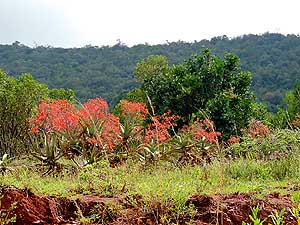
|
-
-
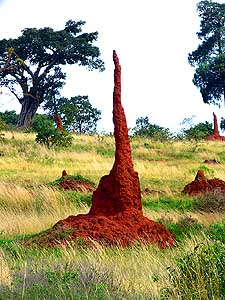
|
-
-
-
-

|
- 019
Cacti are in full bloom, decorating
- the lush green landscape between Yabelo
- and Konso with shiny red dots
|
- 020
Termites are perfect master builders.
- Their thin red towers as high as a house rise
- skywards. Here between Yabelo and Konso
|
- 021
Acacias with their wide spread
- branches are part of the African steppe
- and always a fascinating sight
|
-
|
-
-
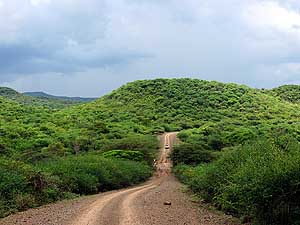
|
-
-
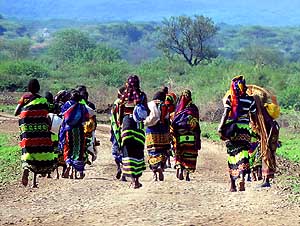
|
-
-
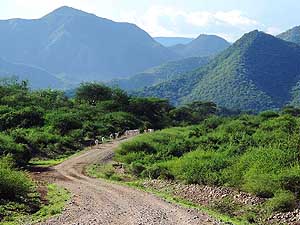
|
- 022
Lush green hills, only interrupted by the
- narrow gravel road, accompany us on a section
- to Konso, where it obviously rained more
|
- 023
Traditionally dressed ladies of
- the Konso tribe walk along the gravel
- road in direction Konso
|
- 024
The verdant mountains appear
- as we near Konso in the
- Southwest of Ethiopia
|
-
|
-
-
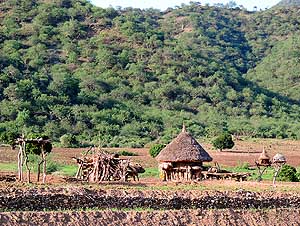
|
-
-
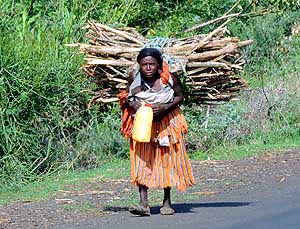
|
-
-
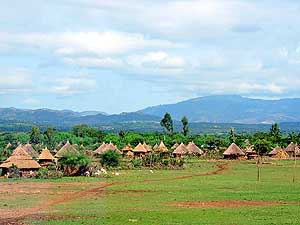
|
- 025
A tiny homestead nestles on a small
- strip of flat land between the gravel road
- and the forest shortly before Konso
|
- 026
In the African bush, women are
- still considered as “pack donkeys”. Due
- to deforestation they often walk great
- distances daily to find some firewood
|
- 027
A neat village with spiky thatched
- roofs along the way to Arba Minch.
- Contrary to often rubbish strewn
- cities, bush villages are clean
|
-
|
-
-
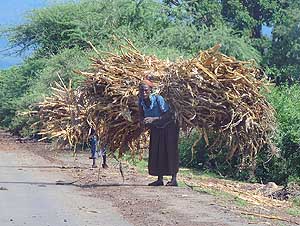
|
-
-
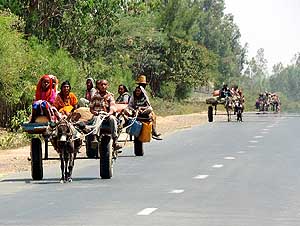
|
-
-
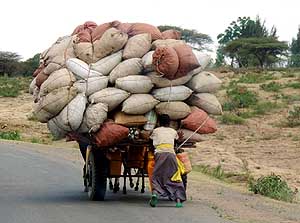
|
- 028
The woman carrying a huge pile of
- straw on her back needs a break while
- collecting the meagerly available “firewood”
|
- 029
Archaic donkey carts carrying
- people and goods are (still) a
- common mean of transport in Ethiopia
|
- 030
The two donkeys are not any more able
- to pull the heavy carriage under their own
- steam. The woman needs to push from behind
|
-
|
-
-
-
-
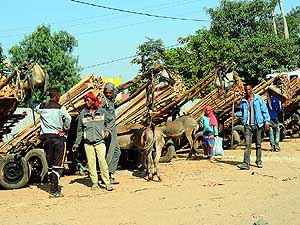
|
-
-
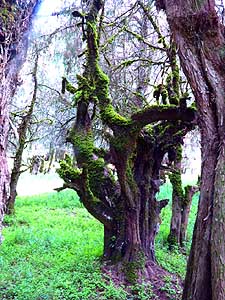
|
-
-
-
-
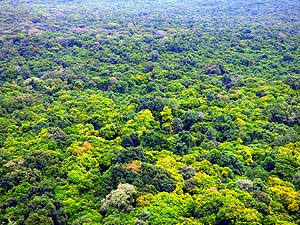
|
- 031
Wood collecting point: Antique
- carts are loaded with wood slats and
- drawn by donkeys to their destination
|
- 032
The moss on the trees is a sign
- of a pretty humid climate, while the
- air carries a lot of oxygen
|
- 033
A piece of nature: View from
- our camping at the “Bekele Mola Hotel”
- in Arba Minch to the green leaf canopy
- of the “Bridge of God National Park”
|
-
|
-
-
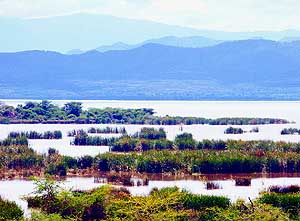
|
-
-
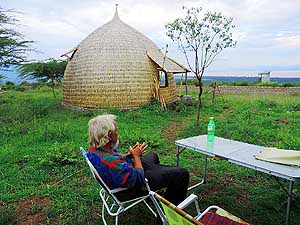
|
-
-

|
- 034
Lake Chamo is besides Lake Abaya
- one of the two Rift Valley Lakes near
- Arba Minch. The “Bridge of God National
- Park” separates it from Lake Abaya
|
- 035
Emil enjoys from our “Bekele Mola
- Hotel” Camping in Arba Minch the view
- over the reddish-brown Abaya Lake,
- with 449 sq.mi. [1’162km²] the
- second largest lake in Ethiopia
|
- 036
Early morning the sky finds
- its reflection on the almost motionless
- surface of Lake Abaya
|
-
|
-
-
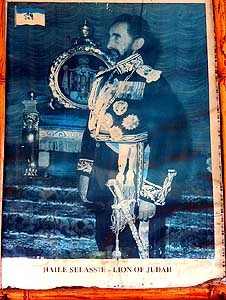
|
-
-
-
-
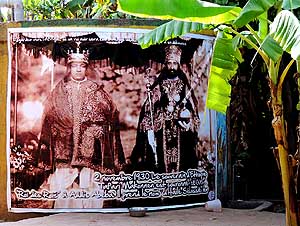
|
-
-
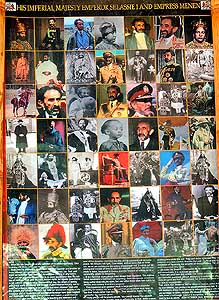
|
- 037
At the Rastafarian Camp “Zion
- Train Lodge” in Shashemene, the portrait
- of Tafari Makonnen, also called “Ras Tafari”,
- decorates the wall. He was as “Emperor
- Haile Selassie I” the last Emperor of
- Ethiopia from 1930 to 1974 …..
|
- 038
….. Coronation poster of November 2nd,
- 1930, of Emperor Haile Selassie I and Empress
- Menen Asfaw. He was crowned “Negusa
- Nagast”, literally “King of Kings” (= Emperor).
- We arrive at the camp on its 85th anniversary,
- on November 2nd, 2015 …..
|
- 039
..... portraits from different stages
- of life of Emperor Haile Selassie I,
- born July 23rd, 1892,
- died (assassinated?) August 27th, 1975,
- and Empress Menen Asfaw
|
-
|
-
-
-
-
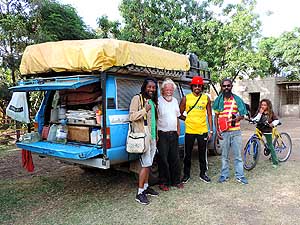
|
-
-
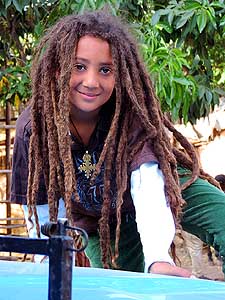
|
-
-
-
-
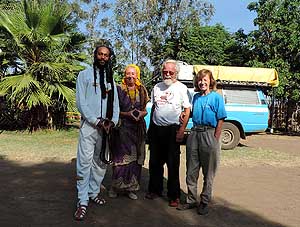
|
- 040
Rastafarians from the Island of
- Réunion visit the Camp “Zion Train
- Lodge” in Shashemene and pose for a
- picture in front of our LandCruiser
|
- 041
Michael, son of the French owners
- of the Rastafarian Camp, is a smart boy.
- He is totally enthusiastic about
- our LandCruiser!
|
- 042
A remembrance picture with the owners
- Sandrine and Alex of Camp “Zion Train Lodge”
- in Shashemene. Emperor Haile Selassie I
- donated 1948 about ½m acres (=0.77 sq.mi.)
- [2km²] of his private land to the Rastafarians
|
-
|
-
-
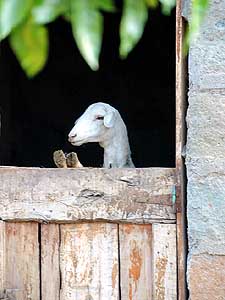
|
-
-
-
-
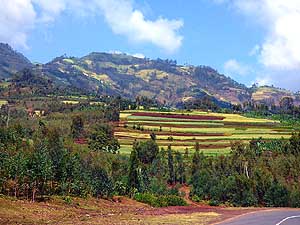
|
-
-
-
-
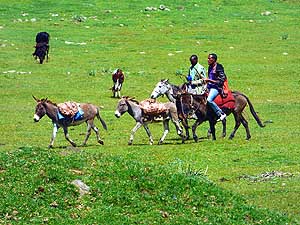
|
- 043
“Is the blue LandCruiser already
- leaving?” The goat at the Camp “Zion
- Train Lodge” in Shashemene peeks
- curiously through the barn window
|
- 044
Cultivated fields in the highlands
- are laid out in terraced patterns. They
- form a colorful patchwork – here on
- the way from Sodo to Shashemene
|
- 045
Men on horseback are
- riding with pack mules through
- the lush green grassland
|
-
|
-
-
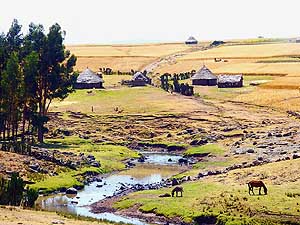
|
-
-
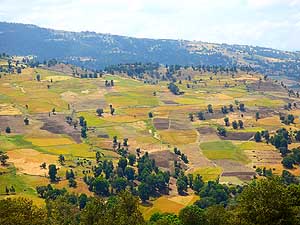
|
-
-
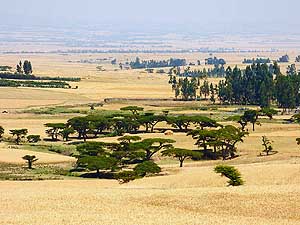
|
- 046
The landscape on the highland
- between Shashemene and the Bale
- Mountains looks like out of a
- picture book
|
- 047
A quaint spot on the Ethiopian
- Bale-Highlands: The combination of
- brown, yellow and green of the
- cultivated fields harmonize wonderfully
|
- 048
Yellow wheat fields, interrupted
- by green umbrella acacias, dominate
- big stretches of the landscape
- around the Bale Mountains
|
-
|
-
-
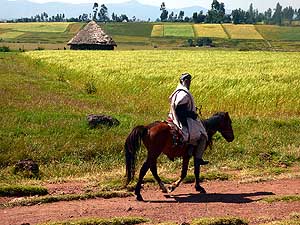
|
-
-
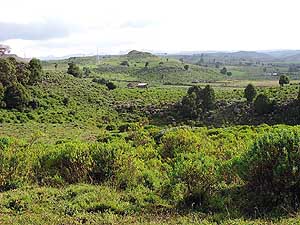
|
-
-
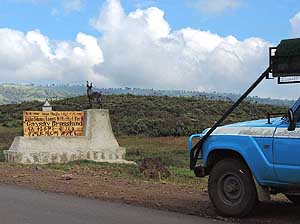
|
- 049
A man is on a routine ride
- through his land with his horse
|
- 050
The landscape in the Bale
- Mountains shows its hilly and green
- character above the Dinsho-Lodge
|
- 051
At the “Gaysay Grassland” sign we
- enter the “Bale Mountain National Park”,
- another candidate to the nine Ethiopian
- UNESCO World Heritage Sites
|
-
|
-
-
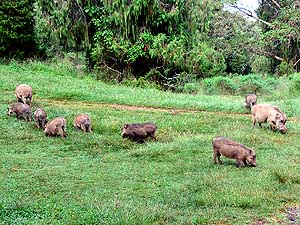
|
-
-
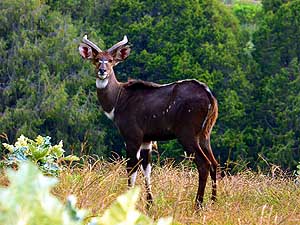
|
-
-
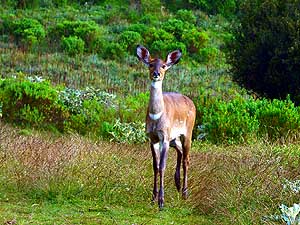
|
- 052
Right after the “Bale Mountain
- National Park” Park sign, warthogs
- (Phacochoerus aethiopicus) are
- grazing by the wayside
|
- 053
A male mountain nyala
- (Tragelaphus buxtoni) looks
- alert in our direction …..
|
- 054
….. also a female stands stone
- still and pricks up its ears until it abruptly
- runs away – just above the Dinsho Lodge
|
-
|
-
-
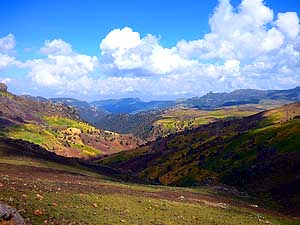
|
-
-
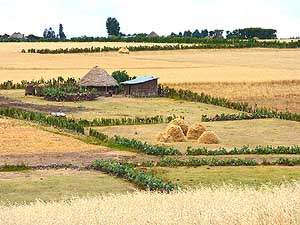
|
-
-
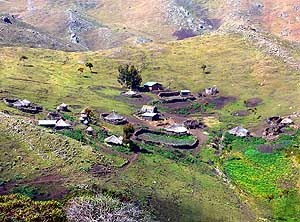
|
- 055
Mountain ridges, gorges and
- escarpments: The mountainous road
- climbs from Shashemene (~ 6’550ft.)
- [2’000m] to the “Bale Mountain
- National Park” over more than 11’800ft.
|
- 056
A little farmhouse surrounded by
- wheat fields. In the highlands grows also
- the smallest millet in the world, called
- “Teff” in Ethiopia. With its flour, the
- National dish “Injera” is made
|
- 057
A remote little farm on the
- highlands along the “Bale Mountain
- National Park” mountain road with
- kraals for their animals
|
-
|
-
-
-
-
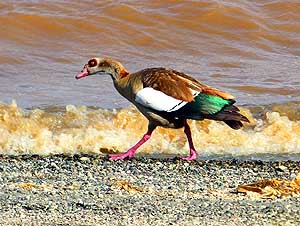
|
-
-
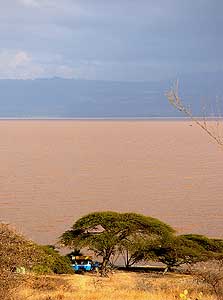
|
-
-
-
-
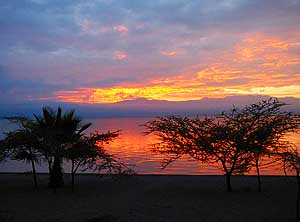
|
- 058
An Egyptian Goose (Alopochen
- aegyptiacus) with a bright plumage wanders
- on the shore of Lake Langano at the
- “Karkao Beach Cottages”. The water is
- brown. stirred up by the fierce wind and
- tributaries carrying soil along …..
|
- 059
….. we set up camp
- beneath a shady acacia at the
- shore of Lake Langano …..
|
- 060
….. next morning at sunrise,
- the pink sky reflects in the calm
- water of Lake Langano
|
-
|
-
-
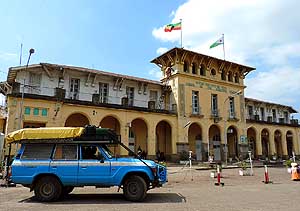
|
-
-

|
-
-
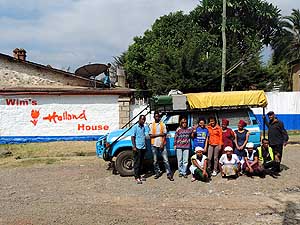
|
- 061
The old train station of the “Chemin
- de Fer Djibouto-Éthiopien” is an attraction
- in Addis Ababa, the capital of Ethiopia on
- an altitude of 7’726ft. [2’350m]
|
- 062
Liliana at the breakfast table
- with three dogs on our camping site at
- “Wim’s Holland House” in Addis Ababa.
- The mega capital has nearly 5m people
|
- 063
The friendly crew of
- “Wim’s Holland House” in Addis Ababa
- gathers around our LandCruiser
- for a farewell picture
|
-
|
-
-
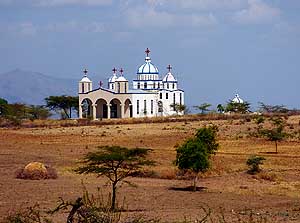
|
-
-

|
-
-
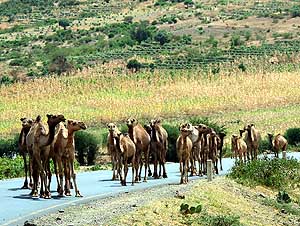
|
- 064
A stately new Christian church rises
- from the Ethiopian savannah between
- Adama (Nazreth) and Awash
|
- 065
Prickly pears, also called opuntia
- (Opuntia microdasys), form a natural
- fence around the modest thatched huts.
- Their fruits are edible
|
- 066
A herd of camels comes our
- way. Camels can travel 350 miles
- [560km] without drinking and have a
- life expectancy of 40 to 50 years
|
-
|
-
-
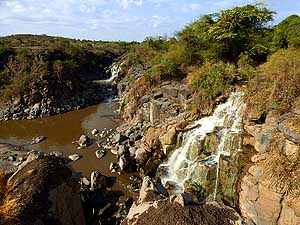
|
-
-
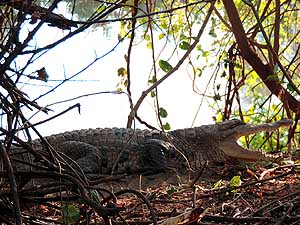
|
-
-
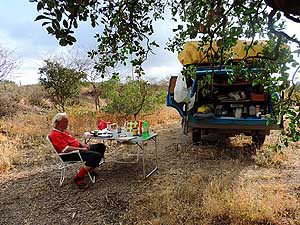
|
- 067
The Awash waterfall in the
- “Awash National Park” tumbles into
- the 500ft. [150m] deep Awash
- Gorge in three sections …..
|
- 068
….. a crocodile
(Crocodylus niloticus)
- is basking in the sun well hidden behind twigs
- on the Gotu campsite in the “Awash National
- Park” at the shore of the Awash River and
- frightens us quite a bit
|
- 069
Breakfast at our bush camp at
- “Awash National Park”. Without a
- long breakfast nothing works for Emil
|
-
|
-
-
-
-
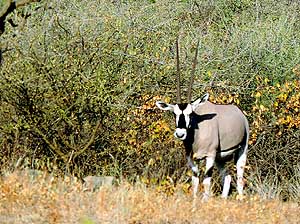
|
-
-
-
-
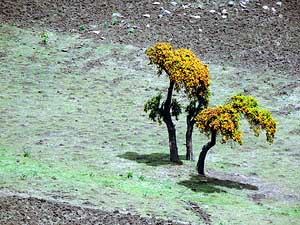
|
-
-
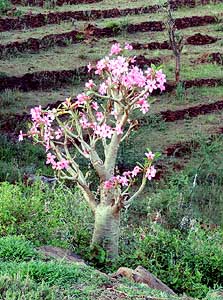
|
- 070
A gracious East African oryx
- (Oryx beisa) in the “Awash National
- Park”. Newborn calves can run with
- the herd immediately after birth
|
- 071
The yellow canopy of the
- two scrubby trees add some
- color to the barren landscape
|
- 072
A bottle tree (Adenium obsium)
- with its delicate pink flowers, also called
- desert roses. It delighted us already in South
- Oman and the Island of
Socotra in
Yemen
|
-
|
-
-
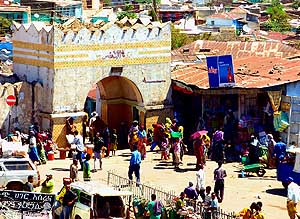
|
-
-
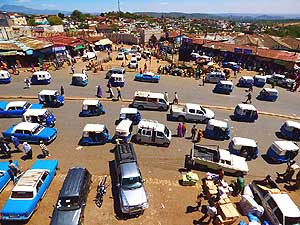
|
-
-
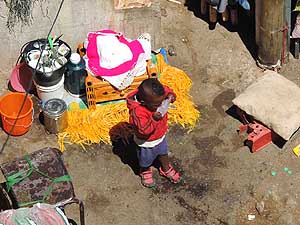
|
- 073
Stepping through the picturesque
- Shoa gate to the 0.4 sq.mi. [1km²] big
- historic fortified old city of Harar in
- Eastern Ethiopia takes us into
- a seemingly Arab world
|
- 074
Taxis and tuk tuks (auto rickshaws)
- from China animate the streets of Harar
|
- 075
A little boy is playing with an
- empty plastic bottle in his backyard.
- Children in Africa are still content
- with such simple things
|
-
|
-
-
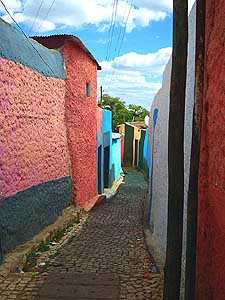
|
-
-
-
-
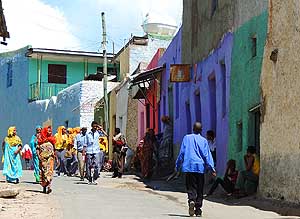
|
-
-
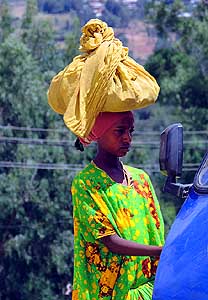
|
- 076
The old city of Harar is a maze of
- twisting and narrow alleyways. It is one
- of the nine UNESCO World Heritage
- Sites in Ethiopia
|
- 077
In Harar’s old city the colorfully
- dressed Harari women compete with
- the brightly painted house facades
|
- 078
A young lady is carrying her
- bundle graciously on her head. She is
- negotiating the fare with one of Harar’s
- tuk tuk (auto rickshaw) driver
|
-
|
-
-
-
-
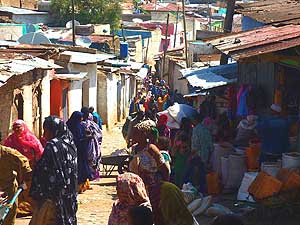
|
-
-
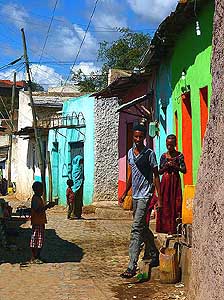
|
-
-
-
-
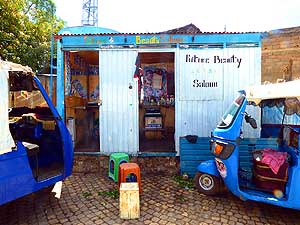
|
- 079
The liveliest alleyway – the Ugga
- Street in the old city of Harar starts right
- at the Shoa gate. Souks, markets,
- mosques and shrines attract big crowds
|
- 080
In Harar’s old city 387
- alleyways are squeezed into
- only 0.4 sq.mi. [1km²]
|
- 081
May it be a facial massage?
- A “beauty salon” in the
- historic city of Harar
|
-
|
-
-
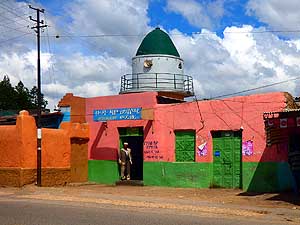
|
-
-
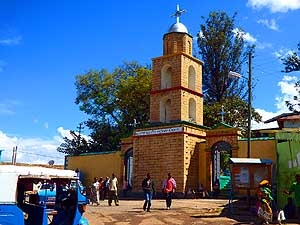
|
-
-
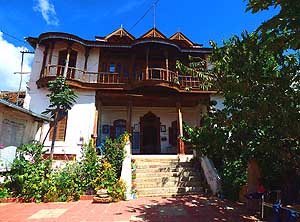
|
- 082
One of the 97 family mosques
- in Harar’s old city with its nice
- and colorful facade
|
- 083
The “Medhane Alem Cathedral”,
- originally an Egyptian mosque, is situated
- at the main square of the old city of Harar
|
- 084
In “Ras Tafari’s House”, Emperor
- Haile Selassie I spent his honeymoon in
- the lovely wooden house of his father
|
-
|
-
-
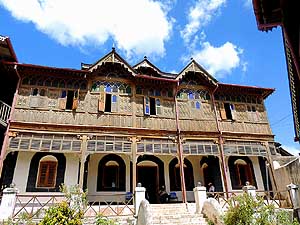
|
-
-
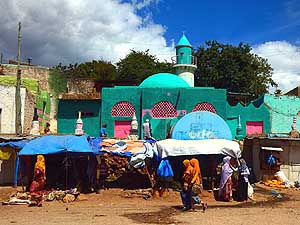
|
-
-
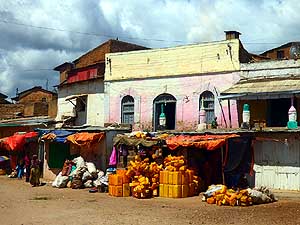
|
- 085
Museum of famous French poet
- Arthur Rimbaud. He lived from 1880
- to 1891 in at that time called Abyssinia
|
- 086
The green-pink mosque with the
- (unofficial?) name “Italian Mosque”
- (Moschea Italiana) is at the market
- square of Harar’s fortified historic city
|
- 087
Yellow water jerry cans
- are for sale. They can be
- seen all over Ethiopia
|
-
|
-
-
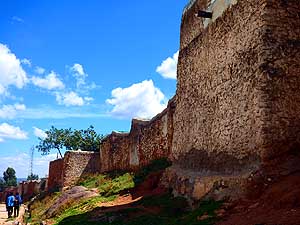
|
-
-
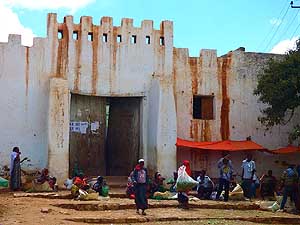
|
-
-
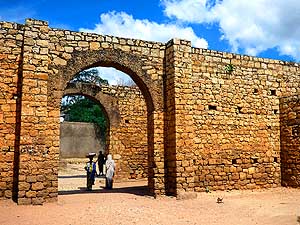
|
- 088
A thick 16ft. [5m] high and
- 2 miles [3.5km] long wall surrounds the
- historic city. The wall was erected in the
- 16th century and was later additionally
- protected by a second outer wall
|
- 089
The Fallana Gate in the North
- is one of the six gates to the fortified
- historic city of Harar
|
- 090
The Buda Gate in the old
- city walls of Harar. Today its
- wooden door is missing
|
-
|
-
-
-
-
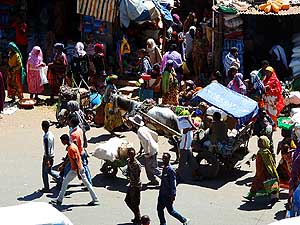
|
-
-
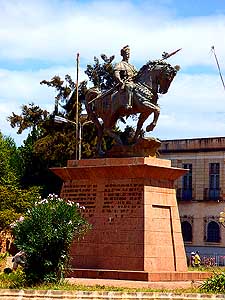
|
-
-
-
-
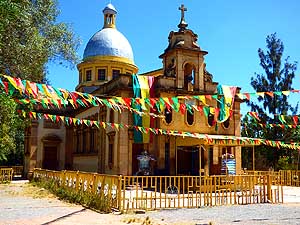
|
- 091
Pushcarts, horse-drawn carts,
- rickshaws, tuk tuk’s, motorbikes. cars
- and in between people and animals –
- Harar is brimming over with activities
|
-
092
On horseback: Statue of Ras
- Makonnen, father of Emperor
- Haile Selassie I, in Harar’s four lane
- main road (Charleville Avenue)
|
- 093
The festively decorated Ras
- Makonnen Church in Harar, where there
- was once also Makonnen’s grave, which
- however decayed (200 yards [200m]
- northeast of the same-named statue)
|
-
|
-
-
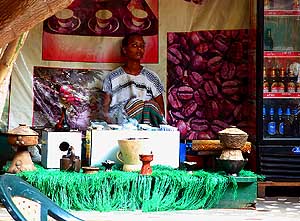
|
-
-
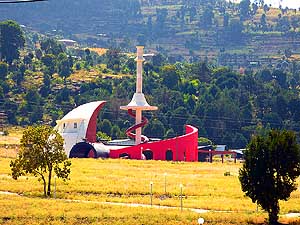
|
-
-
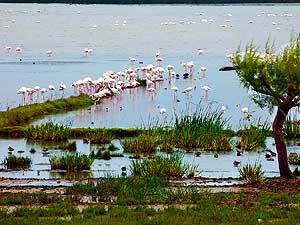
|
- 094
Ethiopian coffee ceremony corner
- at the “Fresh Touch Restaurant” in Harar.
- It belongs to the social and cultural life of
- the country and can be found virtually at
- every hotel, restaurant and suchlike)
|
- 095
The “Oromo Martyr Memorial Statue”
- in Chelenko, in honor of the dead in the
- 1887 battle, is on 7’120ft. [2’170m]
- altitude and 30 miles [50km] from Harar
|
- 096
A flock of flamingoes gather
- at the little Lake Aramy, 11 miles
- [16km] northeast of Harar
|
-
|
-
-
-
-
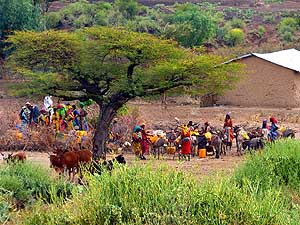
|
-
-
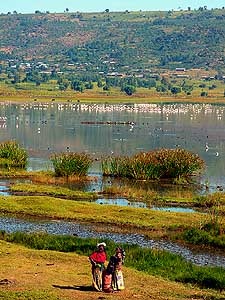
|
-
-
-
-
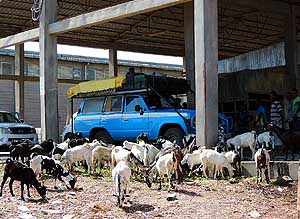
|
- 097
A watering place in a village,
- where people not only gather to collect
- water in yellow jerry cans but
- also to exchange news
|
- 098
Farewell from peaceful
- Lake Aramy near Harar with
- its flamingos in the distance
|
- 099
18.11.2015: We share the Ethiopian
- custom in Galafi to neighboring
Djibouti
- with goats. Despite leaving the country,
- the officer steps on the roof of the car
- and snoops in our large aluminum box
|
-
|
- Continuation to the next Ethiopian page:
Ethiopia
Part 2
–
November 27th to December 9th, 2015, from
Djibouti to
Sudan
|
-
- The "Greater"-Middle East trip 2012/13:
- Sharjah/Dubai/1st Traveler's Festival/Emirates
National Auto Museum - UAE with
car Nov. 2012 to Jan. 2013 - part 1
- Western UAE - Liwa - United Arab Emirates with car in January 2013 - part 2
- Oman 2013 – Part 1 - February
2013: Musandam Peninsula
- Oman 2013 – Part 2 - February
2013: Sohar - Muscat - Rustaq - Nizwa
- Oman 2013 – Part 3 - March
2013: Sur - East Coast - Island of Masirah - Dhofar
- Oman 2013 – Part 4 - March
2013: Salalah & Surroundings (Dhofar) - Nizwa
- Oman 2013 – Part 5 - March 2013: Western Hajar
Mountains
- Al Ain, Eastcoast & Ras al Khaima - United
Arab Emirates with our car in April 2013 -
part 3
- Iran - part 1: Ferry Port Bandar Abbas-Shiraz-Persepolis-Pasargad (between Persepolis and Yazd)
– May 2013
- Iran - part 2: Pasargad
(excl.)-Yazd-Esfahan – May 2013
- Iran - part 3: Esfahan
(excl.)-Chelgerd-Hamadan-Sanandaj-Orumiyeh – May 2013
- Turkey - Esendere-Hakkari-Van-Dogubayazit-Kars-Ardahan-Hopa-Georgia
Border – May/June 2013
- Georgia - part
1: Ajaria-Gori-Tbilisi-Kakheti-Azerbaijan
Border – June 2013
- Azerbaijan: Georgia Border-Balakən-Şəki-Lahıç-Baku-Xınalıq-Quba-Laza-Baku-Gəncə-Georgia Border – June 2013
-
Georgia - Part 2a: Azerbaijan Border-Tbilisi-Armenia
Border –
June/July 2013
- Armenia part 1 – July 2 to 9, 2013: Georgia Border - Akhtala - Haghpat
- Dilijan - Lake Sevan - Selim - Arates - Nagorno-Karabakh
- Nagorno-Karabakh:
Armenia-Stepanakert-Gandzasar-Martakert-Tigranakert-Tnjri-Shoushi-Armenia – July
- Armenia -
Part 2:
Nagorno-Karabakh-Goris-Tatev-Noravank-Khor Virap-Echmiadzin-Yerewan-Geghard-Gyumri-Georgia Border – July 2013
- Georgia -
Part 2b: Armenia Border-Ninotsminda-Tbilisi-Mtskheta-Kazbegi-Kutaisi-Zugdidi –
July 2013
- Georgia -
Part 3a:
Zugdidi-Swaneti-Zugdidi-Abkhazia Border – July/August 2013
- Abkhazia: Georgia-Sukhumi-Tsebelda-Novyy Aton-Lake
Ritsa-Gagra-Pitsunda-Georgia – August
2013
- Georgia - Part 3b: Abkhazia Border-Poti-Ferry to Ilyichevsk/Ukraine
– August 2013
|
-
|
![]()
